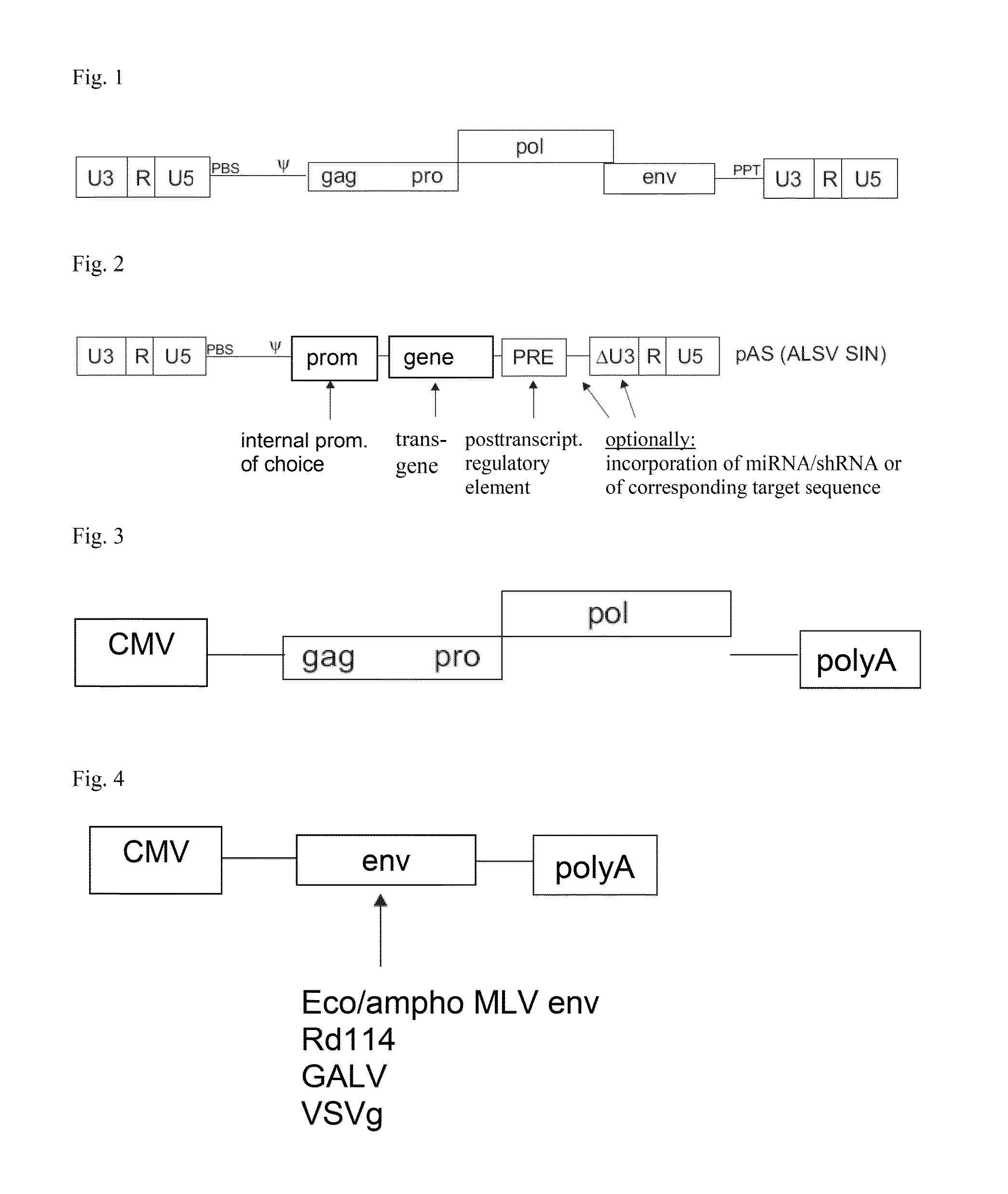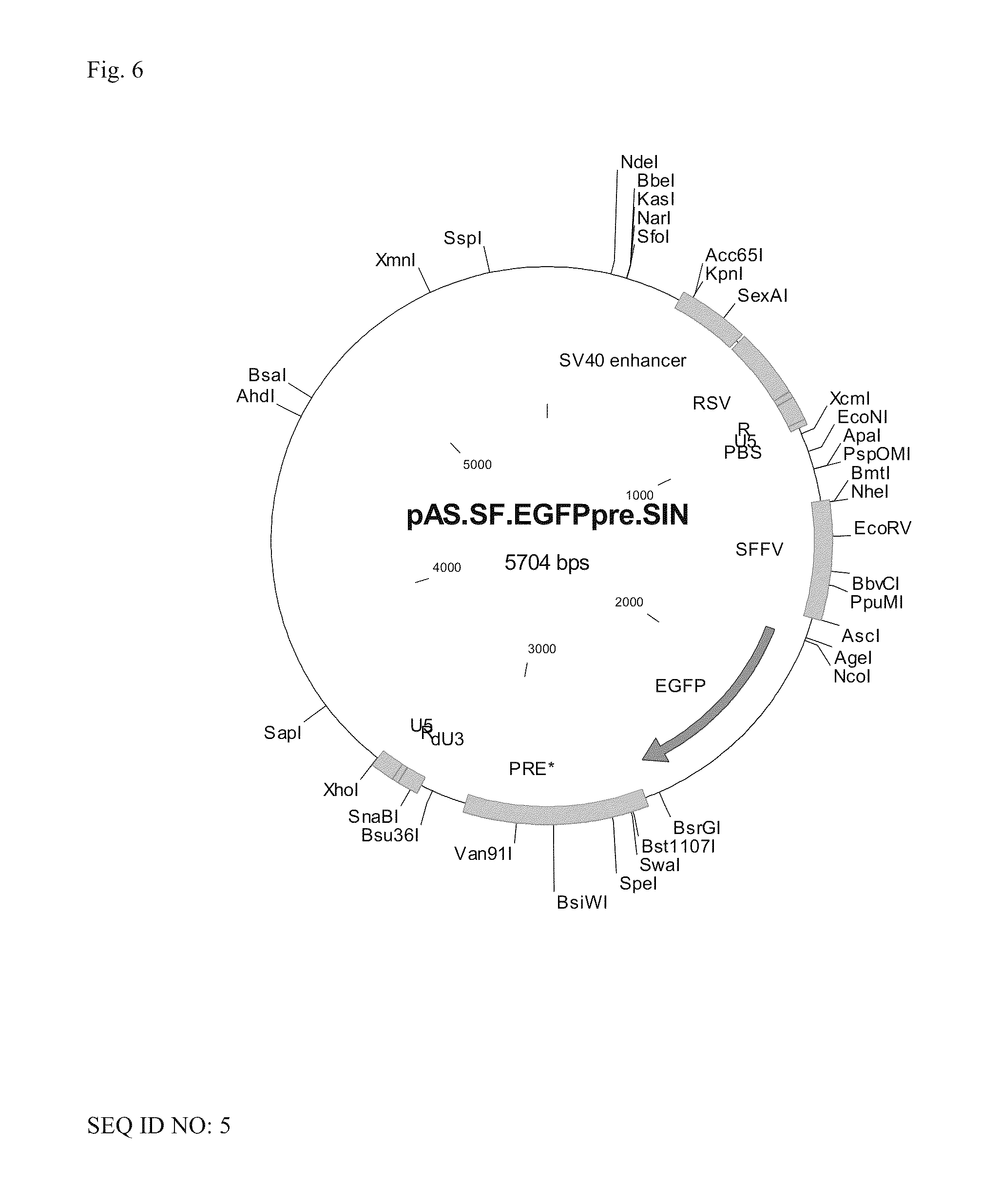ASLV vector system
a vector system and vector technology, applied in the field of aslv vector systems, can solve the problems of making the construction of sin vectors more difficult and the system is usually not suitable for clinical applications, and achieve the effects of minimizing the risk, efficiently transcribed and/or translated, and minimizing the risk of recombination to a replication-competent retrovirus (rcr)
- Summary
- Abstract
- Description
- Claims
- Application Information
AI Technical Summary
Benefits of technology
Problems solved by technology
Method used
Image
Examples
example 1
Production of Viral Particles Having an ASLV SIN Vector According to the Invention
[0070]As examples for vectors according to the invention coding for a viral RNA according to the invention plasmids were constructed which under the control of a promoter of an enhancer element of SV40 (SV40 enhancer) and the RSV promoter (RSV) directly adjacent to the promoter had the R region, the U5 region, an expression cassette for a transgene and a 3′ SIN LTR from a SIN U3 region according to the invention, an R region and a U5 region. The expression cassette comprised the U3 promoter of the spleen focus-forming virus (SFFV), a sequence coding for EGFP as an example for a transgene, and a WPRE (PRE).
[0071]For the vector shown in FIG. 6, the SIN U3 region corresponded to the SEQ ID NO: 2, alternatively to the SEQ ID No: 3 for the vector shown in FIG. 7, and corresponded to the SEQ ID NO: 4 for the vector shown in FIG. 8, respectively.
[0072]The sequence of the vector of FIG. 6 is contained as SEQ I...
example 2
Long Term Expression of the Transgene in Eukaryotic Target Cells
[0089]As an example for the use of the viral vector as a medicament, e.g. for gene therapy, blood stem cells were transduced with viral particles according to the invention. Isolated bone marrow cells from mice (strain C57BL6) were transduced with viral particles according to the invention, and for comparison with lentiviral particles. As a transgene EGFP was contained each time in the same expression cassette under the control of the SFFV promoter. Under conditions of same efficiency the cells were transfected by the lentiviral vector to 39% and therein by the factor of 1.6 more than by the vector according to the invention (24%). This can be attributed to the fact that lentiviral particles can also transduce resting, divisionally inactive cells, while the α-retroviral particles according to the invention preferably can transduce cells during the division.
[0090]The transduced blood stem cells were transplanted into 8 l...
example 3
Demonstration of Lower Risk by Insertional Mutagenesis of the Vectors
[0092]In an in vitro test developed by the inventors (Mol. Ther. 1919-1928 (2009)) the risk of oncogene activation in the transduction and transfection by the viral vector, respectively, was examined. An oncogene activation, e.g. by insertion of viral sequences into the genomic neighbourhood, therein leads to the transformation of primary haematopoietic cells. In short it is investigated in this test in which frequency and to which degree of distinctness the insertional activation of transformation supporting cellular proto-oncogenes like EviI occurs. In this test primary haematopoietic cells of the untreated mouse, e.g. strain C57BL6, are contacted with viral particles. After this transduction the transformation frequency is determined by cultivation under conditions which cause the myeloid differentiation, wherein the renewed seeding is carried out from such cell dilutions in which non-transformed cells do not pr...
PUM
| Property | Measurement | Unit |
|---|---|---|
| nucleic acid sequence | aaaaa | aaaaa |
| pharmaceutical composition | aaaaa | aaaaa |
| frequency | aaaaa | aaaaa |
Abstract
Description
Claims
Application Information
 Login to View More
Login to View More - R&D
- Intellectual Property
- Life Sciences
- Materials
- Tech Scout
- Unparalleled Data Quality
- Higher Quality Content
- 60% Fewer Hallucinations
Browse by: Latest US Patents, China's latest patents, Technical Efficacy Thesaurus, Application Domain, Technology Topic, Popular Technical Reports.
© 2025 PatSnap. All rights reserved.Legal|Privacy policy|Modern Slavery Act Transparency Statement|Sitemap|About US| Contact US: help@patsnap.com



